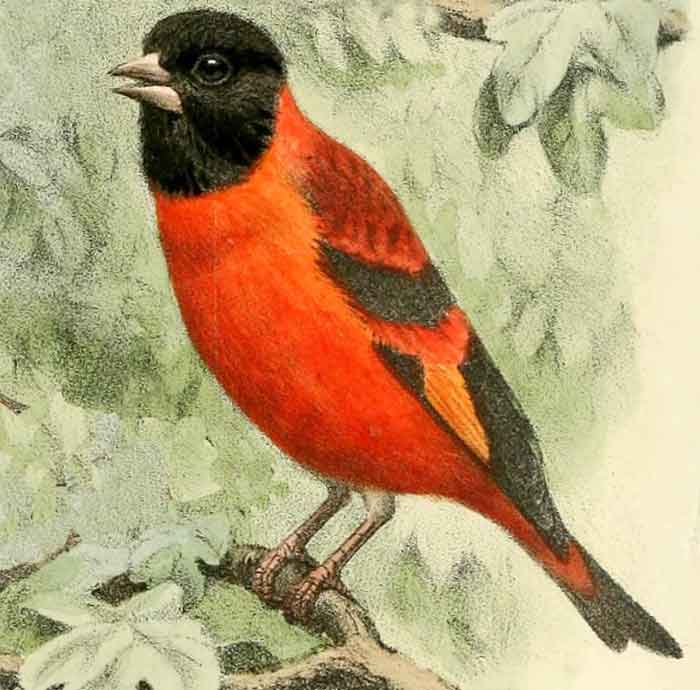
Spinus cucullatus (*)
Superregnum: Eukaryota
Cladus: Unikonta
Cladus: Opisthokonta
Cladus: Holozoa
Regnum: Animalia
Subregnum: Eumetazoa
Cladus: Bilateria
Cladus: Nephrozoa
Superphylum: Deuterostomia
Phylum: Chordata
Subphylum: Vertebrata
Infraphylum: Gnathostomata
Megaclassis: Osteichthyes
Cladus: Sarcopterygii
Cladus: Rhipidistia
Cladus: Tetrapodomorpha
Cladus: Eotetrapodiformes
Cladus: Elpistostegalia
Superclassis: Tetrapoda
Cladus: Reptiliomorpha
Cladus: Amniota
Classis: Reptilia
Cladus: Eureptilia
Cladus: Romeriida
Subclassis: Diapsida
Cladus: Sauria
Infraclassis: Archosauromorpha
Cladus: Crurotarsi
Divisio: Archosauria
Cladus: Avemetatarsalia
Cladus: Ornithodira
Subtaxon: Dinosauromorpha
Cladus: Dinosauriformes
Cladus: Dracohors
Cladus: Dinosauria
Ordo: Saurischia
Cladus: Eusaurischia
Subordo: Theropoda
Cladus: Neotheropoda
Cladus: Averostra
Cladus: Tetanurae
Cladus: Avetheropoda
Cladus: Coelurosauria
Cladus: Tyrannoraptora
Cladus: Maniraptoromorpha
Cladus: Maniraptoriformes
Cladus: Maniraptora
Cladus: Pennaraptora
Cladus: Paraves
Cladus: Eumaniraptora
Cladus: Avialae
Infraclassis: Aves
Cladus: Euavialae
Cladus: Avebrevicauda
Cladus: Pygostylia
Cladus: Ornithothoraces
Cladus: Ornithuromorpha
Cladus: Carinatae
Parvclassis: Neornithes
Cohors: Neognathae
Cladus: Neoaves
Cladus: Telluraves
Cladus: Australaves
Ordo: Passeriformes
Subordo: Passeri
Infraordo: Passerida
Superfamilia: Passeroidea
Familia: Fringillidae
Subfamilia: Carduelinae
Genus: Spinus
Species: Spinus cucullatus
Name
Spinus cucullatus (Swainson, 1820)
Synonyms
Carduelis cucullata (protonym)
Sporagra cucullata (Swainson, 1820)
Spinus cucullata (Swainson, 1820)
References
Swainson, W.J. 1820–1823. Zoological Illustrations, or original figures and descriptions of new, rare, or interesting animals, selected chiefly from de classes of Ornithology, Entomology and Conchology, and arranged on the principles of Cuvier and other modern Zoologists. Vol.1 BHL: I–ix, pl., text 1–66, index. 1820–1821. Vol.2 BHL: pl., text 67–119, index. 1821–1822. Vol.3 BHL: v–x, pl., text 120–182, index. 1822–1823. Baldwin, Cradock & Joy. London. DOI: 10.5962/bhl.title.42279 Reference page. Vol 1 pl. 37 BHL text BHL
Links
IUCN: Spinus cucullatus (Endangered)
Vernacular names
Deutsch: Kapuzenzeisig
English: Red Siskin
español: Jilguero Rojo
suomi: Tulitikli
français: Chardonneret rouge
日本語: ショウジョウヒワ
Nederlands: Kapoetsensijs
русский: Огненный чиж
svenska: rödsiska
Türkçe: Kırmızı iskete

The red siskin (Spinus cucullatus) is a small endangered finch native to tropical South America - in northern Colombia, northern Venezuela (where it is called the "cardenalito") and Guyana.[1] It was common in the early 20th century, occurring throughout the foothills of northern Venezuela, but has now become extremely rare in a fragmented range. The population on Trinidad is believed to be extirpated, with no sightings since 1960.
Habitat
The red siskin is found in open country, forest edges and grassland with trees or shrubs. The female is believed to lay three greenish-white eggs in a grassy cup nest in a tree.
Description
The red siskin is about 10 cm long. The male is mainly deep red, with black on the head, throat, flight feathers and tail tip, and a whitish lower belly and under tail. The female is grey on the head, breast, and upper parts, apart from a red rump and upper tail. The breast is grey with reddish flanks, and the rest of the underparts, the wings and tail resemble the corresponding areas of the male. Immature females are paler than the adults, and immature males are brown rather than red.
Call
The call is a high-pitched chitter and sharp chi-tit like the Indian silverbill, and the male's song is a musical goldfinch-like melody with twitters and trills.
Diet
Red siskins eat seeds and are highly gregarious. When they were more numerous, they formed semi-nomadic flocks.
Conservation
This siskin has been illegally trapped for the cage bird trade[3] and endangered by environmental factors. Domestication has probably been responsible for the continuation of the species, which might otherwise be extinct. This is an attractive finch with a pleasant song, and its unique coloration for a small finch has led to it being used for interbreeding with domestic canaries to produce varieties with red in the plumage.
Conservation status
The red siskin is listed as endangered by the IUCN Red List and nationally critically endangered in Venezuela. It is listed on CITES Appendix I. The greatest threat to the species has been intense illegal trapping for the bird trade since the 1940s, however the species also faces extensive habitat loss.[1] Some hope has been given to this highly endangered species by the discovery in 2003 of a population of several thousand birds in southern Guyana, 1000 km from any previously known colony. Otherwise, the world population is believed to be between 600-6,000 pairs.
Researchers at the Smithsonian Conservation Biology Institute lead a program, the Red Siskin Initiative, with the goals of uncovering more about this species and preventing its extinction.[4] The National Aviary in Pittsburgh, PA has a captive breeding program for the species.[5]
References
BirdLife International (2018). "Spinus cucullatus". IUCN Red List of Threatened Species. 2018: e.T22720374A132138099. doi:10.2305/IUCN.UK.2018-2.RLTS.T22720374A132138099.en. Retrieved 12 November 2021.
"Appendices | CITES". cites.org. Retrieved 2022-01-14.
Sánchez‐Mercado, A.; Cardozo‐Urdaneta, A.; Moran, L.; Ovalle, L.; Arvelo, M. Á.; Morales‐Campos, J.; Coyle, B.; Braun, M. J.; Rodríguez‐Clark, K. M. (2019). "Social network analysis reveals specialized trade in an Endangered songbird". Animal Conservation. 23 (2): 132–144. doi:10.1111/acv.12514. ISSN 1367-9430.
Red Siskin Initiative. "Red Siskin". RSI. Retrieved 2021-01-22.
"Grasslands". National Aviary. Retrieved 2021-01-22.
Birds of Venezuela by Hilty, ISBN 0-7136-6418-5
ffrench, Richard (1991). A Guide to the Birds of Trinidad and Tobago (2nd ed.). Comstock Publishing. ISBN 0-8014-9792-2.
Finches and sparrows by Clement, Harris and Davis, ISBN 0-7136-8017-2
Retrieved from "http://en.wikipedia.org/"
All text is available under the terms of the GNU Free Documentation License

